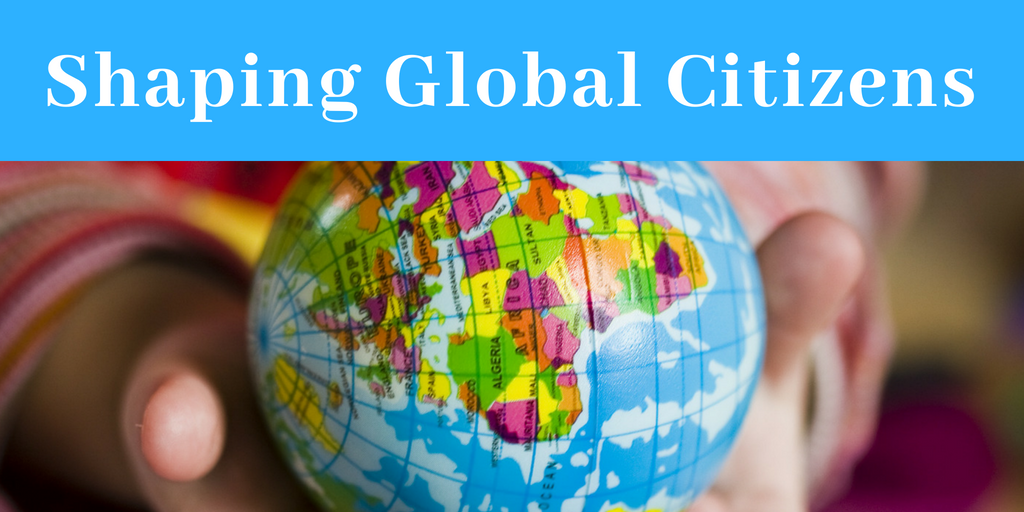
Shaping Global Citizens
Students today are more a part of the global community than ever. Information travels in seconds and we are constantly connected by technology. Today’s educators are faced with the daunting task of shaping students into responsible and well-informed global citizens. The thought of teaching global citizenship is often overwhelming to teachers and can feel like one more thing on a lengthy to-do list. This rings especially true for veteran teachers who experienced the bulk of their own education in a very different global climate. The reality, however, is that creating a globally minded classroom doesn’t have to be overwhelming. With the right training and consistent support teachers can learn to see their classroom through a global lens and once the teaching paradigm shifts students will quickly follow suit.
The US Department of Education states that students with global competency will be able to: investigate the world, recognize perspectives, take action and communicate ideas. With the proper training and enough lead-time teachers can integrate each of these skills into daily classroom instruction rather than adding another lesson to their already busy schedules.
Investigate the World
Many schools are already teaching students to investigate their surroundings by promoting inquiry-based learning. Inquiry may seem most at home in the science classroom, but can easily become the instructional choice for any subject. In order to teach students the information gathering skills required of global citizens we must expose them to primary sources. We must teach them to interact with the media that already bombards them and teach them the value of historical sources so readily available online. Many teachers, however, are uncomfortable stepping away from the textbook. Just as their students, they too need to become familiar with the array of primary sources that are just a click away. Thankfully, there are many PD resources available. Teachers can check out the Library of Congress and Primary Source for free, high quality PD dedicated to teaching with primary sources.
Recognize Perspectives
It’s safe to say that every day, every student, in every school across America interacts with a book. Reading is foundational to education and is a central theme tying kindergarten to twelfth grade. When chosen carefully, books are powerful tools in creating global citizens. They are windows to the world can expose students to a myriad of perspectives and cultures. It’s important to recognize, however, that the literature traditionally taught in American schools has a clear Anglo bias. That’s not to say we should do away with it, but rather that we should strive to choose a balanced and thought provoking variety of books for students of all ages. It can feel intimidating to step away from the books that have always been taught, but there are many lists and resources available to help teachers build a balanced library. This list of books from Scholastic is a great starting point. It offers literature of varied levels that exposes children to perspectives from around the world. For those ready to move beyond the lists, the Action Alliance for Children provides a framework with which to assess literature before sharing it with your students.
Take Action
Take action can be a challenging skill to weave into the traditional American school day. Engaging with real life causes allows for rich real world learning, but it can be messy and unpredictable. Making it a hard ask for teachers scrambling to cover extensive required material. In the best-case scenario, administrators both support and allow teachers to follow a PBL model helping students to choose a cause that’s important to them and to truly take action. Edutopia provides an excellent starter resource for schools considering this path. There are, however, ways for students to take action within the confines of the school day as well. One simple way is by writing letters. Letters allow them to share their opinions with government officials and to become advocates for charitable organizations.
Communicate Ideas
Communication has always been important, but a broadening world calls for increased communication skills. Today’s students must learn to communicate digitally, on paper and face to face. Most teachers are well versed in teaching public speaking and writing, but the digital component of global communication can be intimidating. In order to adequately prepare their students as communicators, teachers must become familiar with the many digital tools used today. Microsoft offers an excellent training on Skype in the classroom. Skype allows students to take virtual field trips and to connect with others around the world. Students can also communicate through digital stories and Story Center offers an array of PD opportunities for teachers to explore.
Our world is quickly changing, but our job as educators remains the same. We must do our very best to equip students to be productive citizens. Not just of their local towns, but also of the world at large. As the world becomes more connected, our responsibility as teachers grows. We are not only responsible for teaching ABCs and 123s, but also for teaching global competencies. It’s a weighty job, but it’s thoroughly rewarding to see students respectfully interacting with and appreciating cultures around the world.